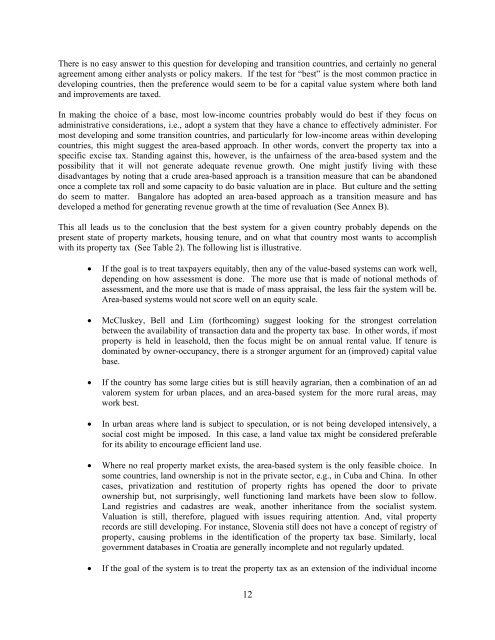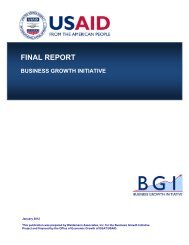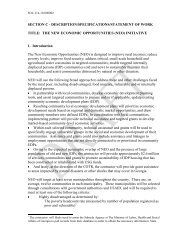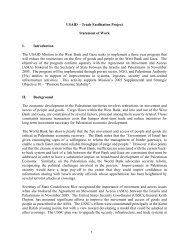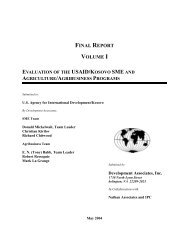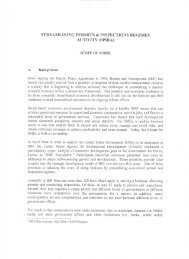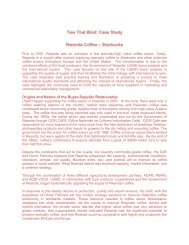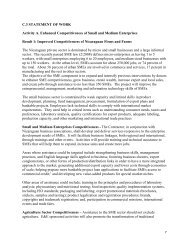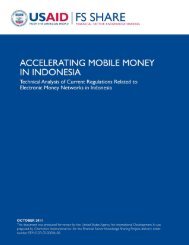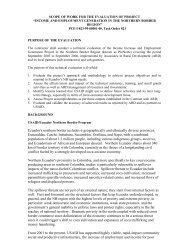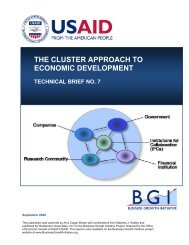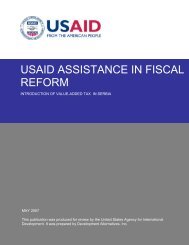Property Tax Reform in Developing and Transition Countries
Property Tax Reform in Developing and Transition Countries
Property Tax Reform in Developing and Transition Countries
Create successful ePaper yourself
Turn your PDF publications into a flip-book with our unique Google optimized e-Paper software.
There is no easy answer to this question for develop<strong>in</strong>g <strong>and</strong> transition countries, <strong>and</strong> certa<strong>in</strong>ly no general<br />
agreement among either analysts or policy makers. If the test for “best” is the most common practice <strong>in</strong><br />
develop<strong>in</strong>g countries, then the preference would seem to be for a capital value system where both l<strong>and</strong><br />
<strong>and</strong> improvements are taxed.<br />
In mak<strong>in</strong>g the choice of a base, most low-<strong>in</strong>come countries probably would do best if they focus on<br />
adm<strong>in</strong>istrative considerations, i.e., adopt a system that they have a chance to effectively adm<strong>in</strong>ister. For<br />
most develop<strong>in</strong>g <strong>and</strong> some transition countries, <strong>and</strong> particularly for low-<strong>in</strong>come areas with<strong>in</strong> develop<strong>in</strong>g<br />
countries, this might suggest the area-based approach. In other words, convert the property tax <strong>in</strong>to a<br />
specific excise tax. St<strong>and</strong><strong>in</strong>g aga<strong>in</strong>st this, however, is the unfairness of the area-based system <strong>and</strong> the<br />
possibility that it will not generate adequate revenue growth. One might justify liv<strong>in</strong>g with these<br />
disadvantages by not<strong>in</strong>g that a crude area-based approach is a transition measure that can be ab<strong>and</strong>oned<br />
once a complete tax roll <strong>and</strong> some capacity to do basic valuation are <strong>in</strong> place. But culture <strong>and</strong> the sett<strong>in</strong>g<br />
do seem to matter. Bangalore has adopted an area-based approach as a transition measure <strong>and</strong> has<br />
developed a method for generat<strong>in</strong>g revenue growth at the time of revaluation (See Annex B).<br />
This all leads us to the conclusion that the best system for a given country probably depends on the<br />
present state of property markets, hous<strong>in</strong>g tenure, <strong>and</strong> on what that country most wants to accomplish<br />
with its property tax (See Table 2). The follow<strong>in</strong>g list is illustrative.<br />
<br />
<br />
<br />
<br />
<br />
<br />
If the goal is to treat taxpayers equitably, then any of the value-based systems can work well,<br />
depend<strong>in</strong>g on how assessment is done. The more use that is made of notional methods of<br />
assessment, <strong>and</strong> the more use that is made of mass appraisal, the less fair the system will be.<br />
Area-based systems would not score well on an equity scale.<br />
McCluskey, Bell <strong>and</strong> Lim (forthcom<strong>in</strong>g) suggest look<strong>in</strong>g for the strongest correlation<br />
between the availability of transaction data <strong>and</strong> the property tax base. In other words, if most<br />
property is held <strong>in</strong> leasehold, then the focus might be on annual rental value. If tenure is<br />
dom<strong>in</strong>ated by owner-occupancy, there is a stronger argument for an (improved) capital value<br />
base.<br />
If the country has some large cities but is still heavily agrarian, then a comb<strong>in</strong>ation of an ad<br />
valorem system for urban places, <strong>and</strong> an area-based system for the more rural areas, may<br />
work best.<br />
In urban areas where l<strong>and</strong> is subject to speculation, or is not be<strong>in</strong>g developed <strong>in</strong>tensively, a<br />
social cost might be imposed. In this case, a l<strong>and</strong> value tax might be considered preferable<br />
for its ability to encourage efficient l<strong>and</strong> use.<br />
Where no real property market exists, the area-based system is the only feasible choice. In<br />
some countries, l<strong>and</strong> ownership is not <strong>in</strong> the private sector, e.g., <strong>in</strong> Cuba <strong>and</strong> Ch<strong>in</strong>a. In other<br />
cases, privatization <strong>and</strong> restitution of property rights has opened the door to private<br />
ownership but, not surpris<strong>in</strong>gly, well function<strong>in</strong>g l<strong>and</strong> markets have been slow to follow.<br />
L<strong>and</strong> registries <strong>and</strong> cadastres are weak, another <strong>in</strong>heritance from the socialist system.<br />
Valuation is still, therefore, plagued with issues requir<strong>in</strong>g attention. And, vital property<br />
records are still develop<strong>in</strong>g. For <strong>in</strong>stance, Slovenia still does not have a concept of registry of<br />
property, caus<strong>in</strong>g problems <strong>in</strong> the identification of the property tax base. Similarly, local<br />
government databases <strong>in</strong> Croatia are generally <strong>in</strong>complete <strong>and</strong> not regularly updated.<br />
If the goal of the system is to treat the property tax as an extension of the <strong>in</strong>dividual <strong>in</strong>come<br />
12


